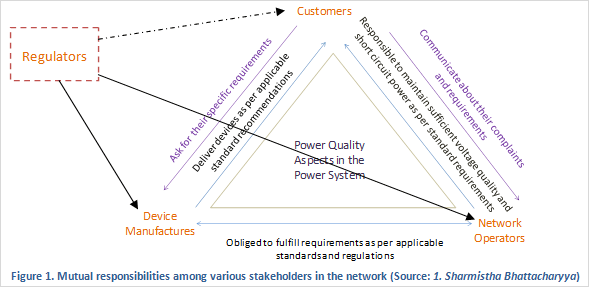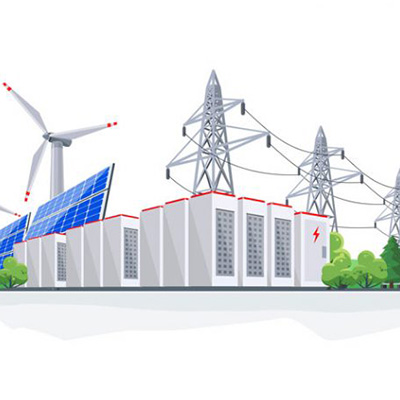Published On: May 03, 2014
India and most developing countries continue to struggle for 24×7 power supply, good Power Quality (PQ)environment, and Energy Efficient (EE) economy. See APQI earlier blog that tries to quantify economic impact from poor PQ environment – Are developing economies at risk due to power quality issues and challenges?
Another follow-up question will be WHO IS RESPONSIBLE FOR MAINTAINING GOOD POWER QUALITY? Another follow-up question will be Answer to this is usually divided and depends upon whom we pose this question. Network Operator will blame his end-customers, Device Manufacturer will blame both the Network Operator and the end-customer, and end-customer usually has not much awareness, and believe that its supply problem from Network Operator.
In addition to above 3 key stakeholders, there are others like – Designers, Commissioning Engineers and Maintenance Engineers that also plays role in sustaining good PQ environment.Commissioning Engineer play the role in ensuring the quality of installation based on certain design standards. Good installation is one of the necessities to maintain power quality during operations and to minimize voltage drop, sparking, overheating, etc. Maintenance engineers are subsequently responsible for preventing any glitches in operations which can result in power quality issue. For ex. loose connections lead to sparking;poor quality of wires results in voltage drops at customers premise, etc.
Further on, we shall focus upon 3 key stakeholders – Customers, Network Operators and Equipment Manufacturers.
INTERCONNECTEDNESS OF OUR GRID AND PQ
>Simply put, Power Quality is a measure of quality of power supply on the grid. A PQ disturbance occurs in case of any deviation of voltage and current waveforms from the ideal. Voltage disturbances commonly originate in the network and affect the customers. On the other hand, current disturbances originate at a customers installation and affect the network components and other installations. Therefore, VOLTAGE QUALITY is considered to be primary responsibility of the network operator, while CURRENT QUALITY is primary responsibility of the end-customers.
Because of interconnected grid, PQ disturbances are caused both by upstream and downstream elements. Across various PQ disturbances , it is observed that customers are responsible for roughly 70% of the PQ problems, while the remaining 30% come from the network.One study by LPQI for 25 European Union countries in 2005-06, reported following % distribution of poor PQ electrical manifestation – transients and surges (29%), voltage dips (23.6%), short interruptions (18.8%), long interruptions (12.5%), harmonics (5.4%) and others (10.7%). (See European Power Quality Survey Report)
‘CUSTOMERS’ AND PQ INTERCONNECTION
Today’s customers are highly dependent on digital technology and power electronic devices, with increasing use of various types of electronic appliances, ballasts, variable speed drives, etc. These devices when used produce current distortions in the network due to their non-linear operating characteristics. These disturbances then travel upstream because of insufficient isolation of each customers from the grid. This increase current in turn causes additional energy losses in the system and also pose increased demand of apparent power to individual customer and also entire network faces the risk of premature aging and failure.
Some of commonly reported PQ complaints from end-customers:
| Equipments affected by poor PQ | External Manifestation of poor PQ | Electrical Manifestation of poor PQ |
| IT equipments | Computer lock-ups and data loss | Presence of earth leakage current causing small voltage drops in earth conductors |
| Variable speed drives, telecom equipments, arc furnace, welding equipment, relays, static converters, security and access control systems, etc. | Motors and drives malfunctioning, computer screen freeze, loss of data | Capacitor bank failure, shocks due to neutral voltage, Flickering of lights, noise in telecom lines |
| Motors and process devices | Malfunctioning of motors and process devices. Extra heating, decreased operational efficiency and premature aging of the equipments. | Presence of voltage and current harmonics in the power supply |
| Relays, circuit breakers and contactors | Nuisance tripping of protective devices | Distorted voltage waveform because of voltage dip |
| Sensitive measurements of process control equipment | Loss of synchronization in processing equipment | Severe harmonic distortion creating additional zero-crossings within a cycle of the sine wave |
Table 1. Customers reported problem due to poor PQ Environment (Source: 2. Sharmistha Bhattacharyya and Sjef Cobben, Technical University of Eindhoven)
With increased awareness, Customers can take below precautions to support building healthy PQ environment:
- Maintain power factor within prescribed limits to reduce reactive power demand, which in turn will balance the voltage in their premise and also overall network
- Reduce harmonic currents while using more energy efficient equipments at their premise
- Keep a log of faced power disturbances at premises, which may come handy in finding effective solutions
‘NETWORK OPERATORS’ AND PQ INTERCONNECTION
The Network Operators design and maintain key network characteristics like feeder length, number and sizing of Distribution Transformers (DT), DT load balancing etc. which in turn determine grid impedance and that influence the PQ level in the network. With high impedance in the network, PQ issues (mainly flicker and harmonics) become more prominent. Further, DT winding configurations and earthing problems also add to the harmonic behavior and voltage dips in the network.
Thus, technical Loss reduction and fixing PQ environment are strongly interrelated, and could be addressed though same investments. The main network components which get affected in terms of faster wear and tear through PQ disturbances are:
- Transformers
- Cables
- Power-factor correction (PFC) Capacitors
- Protective Devices, Digital Relays
- Revenue Meters
The Network Operator can streamline its loss reduction initiatives with improving PQ environment in following ways:
- Controlling voltage level at customers point of connection by reactive power management and take appropriate steps at the broader network level.
- Maintaining load balance at Feeder and DT level, and reduce current losses. This will ensure increased power availability.
- Doing regular PQ Measurements with advancement in technologies like SCADA, Smart Metering, etc. and designing relevant dashboards to facilitate timely actions
- Isolating customer loads and their variations from main grid through use of Capacitor banking. Different variants like automatic power factor correcting devices, switched capacitors, Statics VAR compensators, dynamic voltage regulators etc. are available.
‘EQUIPMENT MANUFACTURERS’ AND PQ INTERCONNECTION
Organized and branded Equipment Manufacturers usually specify PQ immunity (EMI/EMC) of their equipment in terms of harmonic current emission and other parameters, as applicable under some Standards. However, in a real life situation, the network voltage is already distorted (and is non-sinusoidal) because of harmonic current emissions from other loads and customers in the network. This can result into distortions from their devices exceeding the ‘compatibility level’ of the system.
The optimum performance of Equipment Manufacturers’ device is not guaranteed when the supply voltage is distorted. Experiments show that devices produce higher harmonic currents when the supply voltage is distorted. Below table compares total harmonic current distortions (THD) of some households’ devices under sinusoidal and distorted supply voltage condition.
|
Device |
THD with respect to the total RMS current drawn by the device |
|
|
Under clean voltage condition |
Under distorted voltage condition (THD = 6%) |
|
|
TV |
48% |
55% |
|
Personal Computer (PC) |
87% |
89% |
|
Refrigerator |
10% |
18% |
|
CFL |
72% |
79% |
Table2. THD of devices under clean and distorted network voltage conditions (Source: 2. Sharmistha Bhattacharyya and Sjef Cobben, Technical University of Eindhoven)
The device manufacturer, however, cannot be blamed directly for such a situation as he is not responsible for his devices’ operations under a distorted supply voltage condition. But at the same time the manufacturers also need to ensure the immunity of equipments they manufacture against Electro Magnetic Interference (EMI) and specify the tolerance limits for same.
Question is should Manufacturer built in this isolation into its equipments, with resulting price hike, or should customer take collective facility isolation from main grid interference? While answer to this will be driven by market and regulations, still Manufacturers together with their installation teams could start giving weight to PQ issues during their installations and checking some basics like – capacitor bank, cables with larger neutral conductors, adjusting under voltage relays, etc.
CO-CREATING AN ECOSYSTEM FOR BETTER PQ MANAGEMENT
As we saw, poor PQ environment is caused by Customers, Network Operators and also Equipment Manufacturers. At the same time, poor PQ impacts all of them negatively – Network Operator has to face high losses, customers has to face increased break-down of equipments and higher bills, and Equipment Manufacturers has to face increased warranty costs. Therefore, to implement PQ mitigation, a systematic approach needs to be followed starting with to identify the responsibilities of each stakeholder in the network. (A good detailed ‘Decision making flow-chart’ on PQ solutions is shown in report ‘ Consequences of Poor Power Quality – An Overview’ ")".
|
Below figure illustrates the mutual responsibilities sharing among various stakeholders in the network. With growing complexities both on the on end-customer side (via increasing usage of electronic appliances) and Network Operator side (via higher adoption of smart grids, smart meters etc), it is important that each stakeholders understand their contribution and impact from PQ, and take appropriate measures. End-Customers have to become more aware and demanding in their procurements of both power and also equipments, as at the end, it is them who pays out for these in-efficiencies. In US and Europe, there are clear SLAs for voltage supply and harmonics emission at the point of supply between the Network Operator and end-customers. Improved Regulation, policies, standards and end-customer awareness and reinforcement will play key role in guiding market for optimum equilibria for good PQ environment. |
“Stay tune for further blogs and webinars, and building of knowledge on PQ topic. We will like to get your comments, further facts, case studies, experience share, to build vibrant community for knowledge and network share. Please take time to share your comments or suggestions through the Contact Us link or send feedback on info.apqi@copperalliance.org
REFERENCES
- Sharmistha Bhattacharyya, “Power Quality Requirements and Responsibilities at the Point of Connection”
- Sharmistha Bhattacharyya and Sjef Cobben, Technical University of Eindhoven, “Consequences of Poor Power Quality – An Overview”Underground cable damage
- A. de Almeida, L. Moreira. J. Delgado, ISR – Department of Electrical and Computer Engineering, “Power Quality Problems and New Solutions”
- Ministry of Power, GoI, “Strategic Blueprint”
- Central Electricity Authority, “Regulations for Grid Standards”
While the documentation on this website has been prepared with care, Copper Alliance and other contributors provide no warranty with regards to the content and shall not be liable for any direct, incidental or consequential damages that may result from the use of the information or the data contained. Readers may share and redistribute web postings, with due credits to APQI.ORG, on other blogs, or otherwise for private, non-commercial or journalistic purposes. This content may not be used for any other purposes in any other formats or media. The content on this website is provided on an “as-is” basis.








